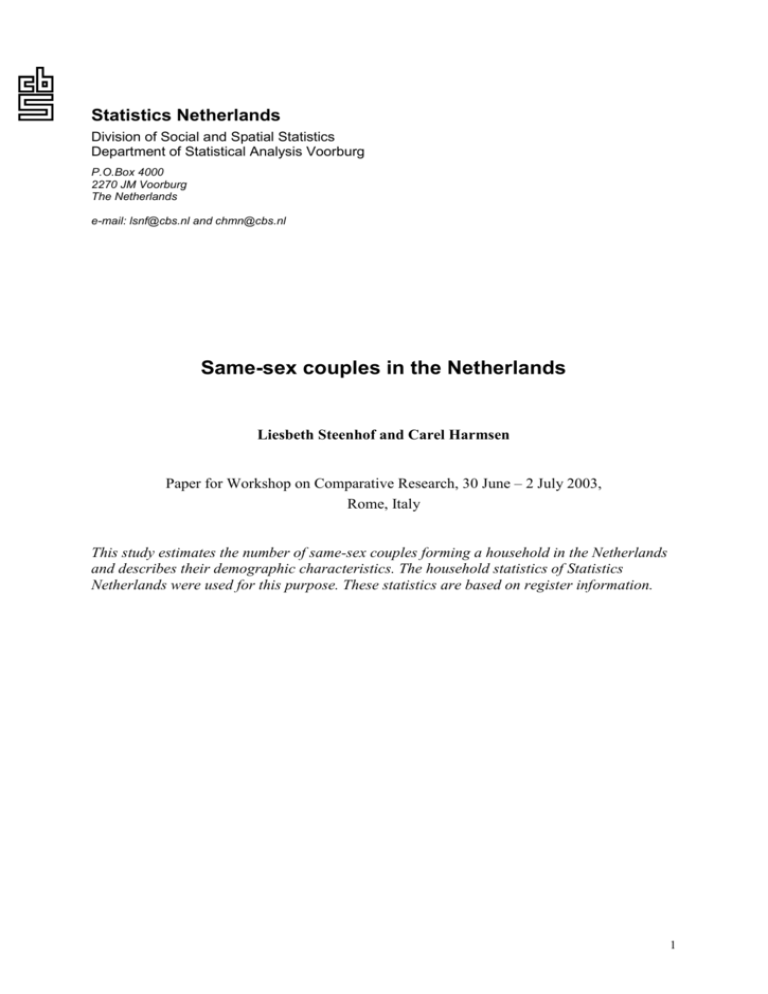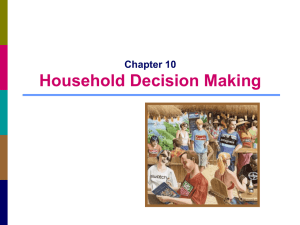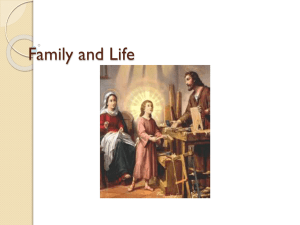New family forms in the Netherlands: same sex couples
advertisement

Statistics Netherlands Division of Social and Spatial Statistics Department of Statistical Analysis Voorburg P.O.Box 4000 2270 JM Voorburg The Netherlands e-mail: lsnf@cbs.nl and chmn@cbs.nl Same-sex couples in the Netherlands Liesbeth Steenhof and Carel Harmsen Paper for Workshop on Comparative Research, 30 June – 2 July 2003, Rome, Italy This study estimates the number of same-sex couples forming a household in the Netherlands and describes their demographic characteristics. The household statistics of Statistics Netherlands were used for this purpose. These statistics are based on register information. 1 1. Introduction Since 1 January 1998 same-sex couples are allowed to register their relationship in a registered partnership under Dutch law. Since 1 April 2001 marriage is open to same-sex couples (graph 1). The Netherlands is the first country that officially allows same-sex marriages. 1. Same-sex marriages and registered partnerships per quarter 700 600 500 400 300 200 100 0 I II III 1998 IV I II III IV 1999 I II III 2000 IV I II III IV I 2001 male marriages female marriages male partnerships female partnerships II III IV 2002 Although marriages and registered partnerships make the group of same-sex couples more visible in a statistical sense, the majority of this group, the consensual unions, do not show up in the population registers. As a consequence, few demographic facts have been published about them until now. This study estimates the number of same-sex couples forming a household in the Netherlands, and describes their demographic characteristics. The household statistics of Statistics Netherlands were used to estimate the number of same-sex couples. These statistics are based on register data and contain the number of households divided into household types, and persons living in households divided into household positions, in the Netherlands on 1 January of the year. In the next two sections we explain more about register data and household statistics. In sections 4 and 5 we describe how the number of same-sex couples and their demographic characteristics are estimated. 2. Dutch population register data1 The Dutch population and household statistics compiled by Statistics Netherlands are based on the automated municipal population registers. This registration system is known as the GBA system, which stands for ‘Gemeentelijke Basis Administratie persoonsgegevens’, the municipal basic registration of population data. ‘Basic’ refers to the fact that the GBA serves as the basic register of population data within a system of local registers. These registers include the local registers on social security, the local registers of water and electricity supply, the local registers of the police departments dealing with the foreign population in the Netherlands, and the (national) registers of the old age pension fund system. 1 This section is based on Prins, 2000. 2 2.1. The GBA-system in short The GBA system was introduced on 1 October 19942. It is a fully decentralised, comprehensive and cohesive population registration system. Due to legal provisions there is no central counterpart of these municipal registers. In this respect the system is unique in the world. Every municipality in the Netherlands has its own population register containing information on all inhabitants of that municipality. This information is listed per individual inhabitant in a so-called personal list (PL). In the registration system each inhabitant has been given a unique personal identification number (PIN), which enables the municipal authorities to link his or her data to those on the spouse, parents and children. For this reason not only the inhabitant’s PIN is stored on each PL, but also those of the parents, the spouse and the offspring. The main features of the GBA system are: - the municipalities have retained responsibility for storing and supplying data. There is no central database; - central government has developed an electronic communications network which links all municipalities and users of population data; - this network provides fully standardised communication between all municipalities and users of population data; - the network is an electronic mail system, according to the EDI principle (Electronic Data Interchange). Interactive real-time data exchange is possible; - central and local government maintain the network jointly. 2.2. Contents of the population registers A personal list (PL) consists of, among other information the following categories: 1. personal data; 2. data about the mother; 3. data about the father; 4. data about marriage, partnership, widowhood and divorce; 5. data about the address; 6. data about the offspring; As mentioned before, the population registers are a basic element in national and local government. This is why much attention was paid to the rules with respect to keeping the population register data up-to-date. The information needed to update these registers is provided by either the local registrar (births, deaths, marriages, partnerships), the judicial courts (divorces), the Ministry of Justice (changes of citizenship) or the persons concerned (house moves, immigration, emigration, births / marriages / other events that took place abroad). In a number of situations the population register does not match reality: - Among young people, students for instance, the proportion of misregistrations seems higher than among other groups. Those who move house should notify the municipality of new residence. This is not always done directly after the move. - An unknown number of people live in the country without being registered in the population register. - Emigrants should notify the local authorities of their departure. However, they often fail to do so. Some just forget, others just do not take the trouble of going to town hall. - Events that have taken place abroad are usually registered with some delay. Marriages contracted abroad are the most striking example of delayed registration. 2 Until 1 October 1994 the population registers were a paper card system. Dutch population statistics were based on those registers, as described by Van den Brekel (1977). 3 2.3. Statistics Netherlands authorisations Statistics Netherlands has been authorised to obtain all data from the municipal population registers the statistical office needs to compile population statistics, given the national needs and the needs of international organisations such as the UN, Eurostat and the Council of Europe. Every year in January Statistics Netherlands obtains a fixed set of data about all inhabitants of the Netherlands. These data are primarily used to give a statistical overview of the population on 1 January. These data are also essential for the household statistics. 2.4. Combining electronic GBA-messages The GBA-system is an individually oriented system of population data storage. The personal lists (PLs) display data per individual. Relations with spouse, children and parents are shown by means of Personal Identification Numbers (PINs). The construction of data on the nuclear family and on households is an example of combining data about various persons. The minimum condition for people to be grouped in the same nuclear family is that they live at the same address. Relations between persons at the same address can be detected by means of the PINs. We assume that young children are in a nuclear family unless the data indicate otherwise. Starting with the youngest person at the address, this person’s parents are detected through the mutual PINs. The same procedure is followed for the other persons at the address. The Dutch population statistics are completely based on the municipal population register data. This means that Statistics Netherlands accepts the register data at face value. No further investigations are carried out on the data that are received from the population registers. Of course Statistics Netherlands is aware of the possibility that not all data are fully correct. As was indicated in section 2.2., some people may be registered at a different address than the one at which they actually live. Although this may affect the family and household statistics, no attempts are made to correct these data. 3. Household statistics The household statistics of Statistics Netherlands are derived every year and contain the number of households divided into household types, and persons living in households divided into household positions, in the Netherlands on 1 January. Data on households refer to the population in private and institutional households. Private households consist of one or more persons sharing the same address and providing for their own daily needs. A person in a one-person household is referred to as single. The members of multi-person households can be classified according to their position with respect to the so-called reference person3. The following positions for those members can be distinguished: - child(ren) living at parental home; - living together; - other. Children may be blood-related, stepchildren or adopted children living with (one of) the parent(s) and not having any children of their own living at home. If two persons are living together, it is assumed that they have a steady relationship. ‘Other members’ of the household are for example boarders, foster children and parent(s) of the reference person or of the partner. Persons living with their children but without a partner at the same address are included in the category ‘single parents’ (table 1). 3 The reference person is a statistical entity. The reference person in a heterosexual relationship is always the man. In homosexual and lesbian relationships, the reference person is the elder of the two. 4 1. Persons in households, 1 January 2002* Age child single group persons living together not married married single parent other member institutional total x 1000 male female 0-14 1520 - - - - 10 4 1534 15-64 5529 966 911 674 2778 56 103 42 65+ - 163 28 656 9 22 31 909 total 2487 1074 702 3433 65 134 77 7972 0-14 1452 - - - - 10 3 1464 15-64 676 711 658 2921 308 77 28 5379 65+ - 569 30 511 38 37 104 1290 total 2128 1280 689 3432 346 123 134 8133 4615 2354 1391 6866 411 257 211 16105 total * provisional data The population in institutional households consists of persons whose accommodation and daily needs are provided for by a third party on a professional basis. It includes persons living in homes for the elderly, nursing homes and mental hospitals. The type of household depends on the relation of its members to the reference person, marital status and offspring. If the reference person is the only person at an address, it is clear that this is a one-person household. Households may also consist of unmarried couples with or without children, and of married couples with or without children. The presence of an ‘other member’ in these households does not effect the classification by type of household. A household consisting of more than one person, where the reference person neither has a partner nor children, is included in the category 'other household'. If the reference person is not cohabiting but has children living at home, the category 'single parent household' applies (table 3). 3.1. Directly derived households The main input for household statistics are integral data on the Dutch population which Statistics Netherlands obtains from municipal population registers (GBA system, see section 2). First, all persons living in an institutional household are classified as such based on address information. After this, persons in private households are derived. For every single identifiable address the persons living on that address are identified together with their (family) relationships. Register information gives information about family ties. Every personal record contains information on parent(s) and of all children born, irrespective of their present residence. There is also information about the partner of the person. Together with the detailed address information it is possible to identify all traditional nuclear families. Obviously, persons living alone at an addresses form a one person household. When more than one person lives at an address either: 1. all persons at the address are related to each other; 2. one or more persons are not related to other persons living at the address. In the first case the household position and composition is derived directly from the family composition. These are married couples with and without children, single parent households, most other households and some non-married couples with children. 5 There are a number of specific cases in which the household composition is derived by taking certain decisions. The most important decisions are: - Other persons related to the family nucleus, that is brothers/sisters or grandparent(s): if such a relationship can be identified such persons become part of the household. As a general rule these persons are classified as other members of the household. In the case of two related families the youngest couple is considered the family-nucleus. The other family members are classified as other members of the household. - Addresses where two brothers/sisters live together are classified as other households. Linking these two persons is possible because the information on the parents is the same. - Persons aged 15 or younger living at an addresses without an identifiable parent are classified as other household members in case there is one other family living at an addresses. - When two non-related persons came to live at an address at the same day these two persons are classified as a two-person household. - At addresses with more than one family unit which are unlike the type of addresses mentioned in paragraph 3.2, the household composition is the same as for the separate families living at the address. If a couple with children, grandmother and two nonfamily persons live at an addresses, the households at that address are the couple with children with one other household member, and two one-person households. 3.2. Imputation Most of the household information is derived from the population registers. However, these registers do not contain all the information that is required to distinguish all the different types of households. The position in the household and the composition of the household can be established if the relationships between persons living at the same address is clear. This is the case for roughly 93 percent of the Dutch inhabitants. The remaining 7 percent of the population in households is imputed on the basis of a logistic regression model. For this purpose six groups of addresses are made: 1. Two ‘unattached’4 persons living at an address; 2. Three ‘unattached’ persons living at an address; 3. Four to nine ‘unattached’ persons living at an address; 4. One single-parent family and a ‘unattached’ person living at an address; 5. One couple and one ‘unattached’ person living at an address; 6. Addresses as mentioned above with a postal classification identifying more than one separate postal unit (a kind of substitute for households) at the address. 3.3. Logistic regression In order to impute household compositions based on logistic regression the Labour Force Survey (LFS) data are used to determine the relationship between background variables and the probability of forming one household. In this paper we only describe the imputation of households at addresses with two ‘unattached’ persons, because this is by far the largest group of addresses to be imputed. Besides, the method of imputation is roughly the same for all groups. For this reason persons living at an address for which Labour Force Survey information is available are coupled with the address composition based on information from the municipal population registers on the date the labour force survey is sampled. Records of the municipal addresses where two ‘unattached’ persons live are selected, including the household information from the labour force survey. This concerns about 4000 addresses observed in two successive years. These records form the basis for a logistic regression which is done to 4 ‘Unattached’ means that no identifiable family ties are present between the persons 6 identify the variables that determine the probability that the persons living at an addresses are part of two households. The model for 2002 consisted of the following variables (table 2): - Age difference between the two persons (DIFAGE) - Average age of the two persons (AVAGE) - Degree of urbanization: 1 = highly urbanized, 5 = not urbanized (URBAN) - Number of never married persons (NONMAR) - Interaction of age difference by same-sex (DIFAGE by SAMESEX) - Interaction of average age by same-sex (AVAGE by SAMESEX) - Interaction of number of never married persons by same-sex (NONMAR by SAMESEX) - Sex of the eldest combined with sex of the youngest person: male/female, female/male, same-sex (SEX) 2. Logistic regression for the probability that two ‘unattached’ persons are part of 2 households B S.E. Wald df Sig. Exp(B) DIFAGE 0,139 0,020 46,200 1 ,000 1,149 AVAGET 0,078 0,022 13,178 1 ,000 1,081 URBAN -0,360 0,060 35,469 1 ,000 0,697 1,924 0,373 26,560 1 ,000 6,849 DIFAGE by SAMESEX -0,049 0,013 15,121 1 ,000 0,952 AVAGE by SAMESEX -0,054 0,014 15,661 1 ,000 0,948 NONMAR by SAMESEX -1,209 0,243 24,674 1 ,000 0,298 102,409 2 ,000 NONMAR SEX SEX(1) -7,390 0,782 89,228 1 ,000 0,001 SEX(2) -6,533 0,799 66,872 1 ,000 0,001 2,268 0,563 16,252 1 ,000 9,662 Constant The information derived from this coupled LFS/Municipal registers file is used to impute the household variables on all the addresses with two ‘unattached’ persons in the municipal registers. The parameter estimates determine the probability of the two persons belonging to one household for every address with two ‘unattached’ persons. This probability varies with the parameter estimates. In the production line the imputation is done by using a cumulative imputation probability. Every time this probability crosses an integer value, that specific address is imputed as two households. Every time the cumulative probability doesn’t cross an integer value the household becomes one household. In determining the household composition, the coupled addresses are also imputed ignoring the knowledge about the composition from the LFS. 3.4. Imputed households Overall 10 percent of the households is determined by imputation. Table 3 shows that unmarried couples without children are the most difficult group to determine. About half of these couples are based on estimation rather than observation. About three quarters of the unmarried couples with children are based on observation. Most of the remaining quarter comes from addresses containing a single parent and an ‘unattached’ person. 7 3. Private households, 1 January 2002* Households Not-imputed households Not-imputed households (x 1000) (x 1000) (%) married couples without children 1535 1535 100 married couples with children 1898 1898 100 unmarried couples without children 499 264 54 unmarried couples with children 197 152 77 single parent household 412 374 91 2345 1908 87 49 33 70 6935 6164 89 one person household other household total * provisional data 4. Estimating same-sex couples An estimate of the total number of same-sex couples can be made on basis of the household statistics. The household statistics of Statistics Netherlands shows that there are about 60 thousand two-person households with two ‘unattached’ persons of the same sex. 2. Age distribution of persons in households with two persons of the same sex, 1 January 2002* male female 85+ 75-79 65-69 55-59 45-49 35-39 25-29 15-19 12000 8000 4000 0 0 4000 8000 12000 8000 12000 3. Age distribution of partners in same-sex couples, 1 January 2002* male female 85+ 75-79 65-69 55-59 45-49 35-39 25-29 15-19 12000 8000 4000 0 0 4000 * provisional data 8 Graph 2 shows the age distribution of this group. The number of persons per age group peaks in the age category 20-24 years for women and in the age category 25-29 for men. Among these age categories there are many students or young working people living with another person of the same sex as roommates. It is important to distinguish this group of two-person households from the group of couples (steady relationships), since we want to estimate the number of same-sex couples only. This distinction cannot be made directly from the household statistics. To estimate the number of same-sex couples, we assume that households with two persons of the same sex without a steady relationship exist only among students and young working people. They are mostly aged under 30. We suppose that the number of people over 30 who live as same-sex couples can be derived directly from the household statistics. The number of persons living as same-sex couples under 30 is estimated in another way. For this estimate we use the same-sex to opposite-sex ratio for cohabitants aged between 30 and 39 living together. We assume that this ratio is the same for people under thirty. The opposite-sex cohabitants aged under 30 are derived directly from the household statistics. This is because we suppose that the number of students and young working people among these two-person households is very low. By combining this proportion with the number of heterosexual partners in the age groups under 30, we determined the total number of cohabitants. As a result we can derive the number of same-sex partners under 30. With this method we can show an age structure of partners in same-sex couples (graph 3). The number of persons aged below 30 is considerably lower than in graph 2. The number of same-sex cohabitants peaks between age 30 and 40, the same as for opposite-sex cohabitants. 5. Demographic characteristics of same-sex couples 5.1. Total number The estimation method described above leads to a total number of almost 48 thousand samesex couples living in the Netherlands on 1 January 2002. This group has increased by about 9 thousand since 1 January 1995 (graph 4). 4. Number of same-sex couples, 1 January 50000 40000 30000 20000 10000 0 1995 * provisional data 1996 1997 1998 male 1999 2000 2001 2002* female The number of male couples has increased, from about 20 thousand couples in 1995 to 26 thousand couples in 2002. The increase in female couples was less striking. This group developed with 3 thousand to almost 22 thousand. As a consequence the proportion of male couples in the group same-sex couples has risen. In 1995 the ratio of male to female couples was almost the same. In 2002 this ratio increased to 54 percent. 9 Although the number of same-sex couples has risen considerably over the last 7 years, their proportion in the total group of married and unmarried couples has remained unchanged, namely less than 1.5 percent. 5.2. Marriages and registered partnerships Five percent of the male and female couples is married: about 1.3 thousand male and 1.1 thousand female couples. Ten percent of the couples has a registered partnership: 2.5 thousand male and 2.3 thousand female couples (graph 5). In total 15 percent of the male and female same-sex couples has registered their relationship through marriage or partnership. 5. Existing marriages and partnerships among same-sex couples, 1 January 2002* 3000 2000 1000 0 male female marriages male female partnerships * provisional data 5.3. Children In about 9 percent of the households of same-sex couples there is at least one child. However, there is a large difference between male and female couples. About 18 percent of the female couples has a child, as opposed to 1 percent of the male couples (graph 6). On 1 April 2001 it became possible for same-sex couples to adopt a child. Female couples can conceive children during their relationship. Many of the same-sex couples with children have their children from a previous heterosexual relationship. About a quarter of all partners in homosexual couples have been married before. These were almost all heterosexual marriages, given the small time period between the legalisation of gay marriages and the reference date of 1 January 2002. 6. Same-sex couples with children, 1 January 2002* 20 % 15 10 5 0 male female * provisional data 5.4. Residence The four biggest towns in the Netherlands are Amsterdam (735 thousands inhabitants), Rotterdam (599 thousands inhabitants), the Hague (464 thousand inhabitants) and Utrecht (265 thousand inhabitants). 10 percent of all married and unmarried couples live in one of these four towns. This percentage is much higher in the group of same-sex couples, namely one in four. Amsterdam is especially popular. Here, same-sex couples represent 5 percent of all couples living there. In the Hague the share is less than 3 percent, in Utrecht just over 2 10 percent and in Rotterdam just under 2 percent. In the Netherlands as a whole this percentage is just over 1 percent (graph 7). 7. The ratio of same-sex couples to the total number of couples, 1 January 2002* % 5 4 3 2 1 0 Amsterdam the Hague Utrecht Rotterdam the Netherlands *provisional data 6. References Van den Brekel, J.C., 1977, The use of the Netherlands system of continuous population accounting for the population statistics (Statistics Netherlands internal paper). Prins, C.J.M., 2000. Dutch population statistics based on population register data. Maandstatistiek van de bevolking, februari 2000, p. 9-15. 11







